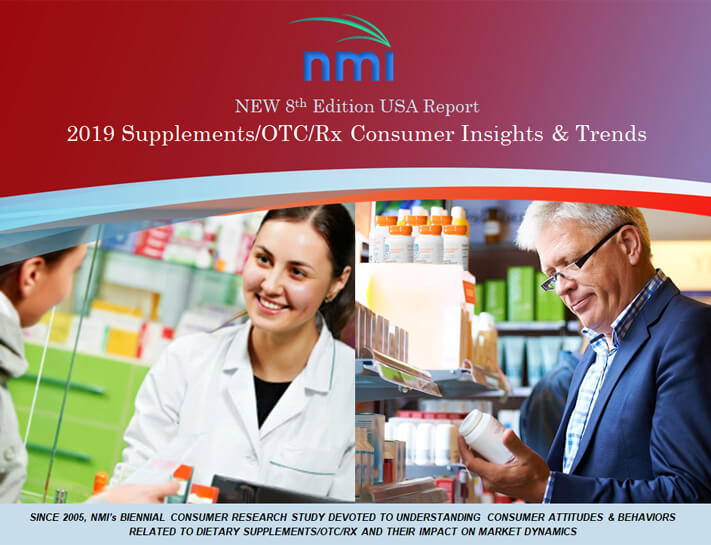8th Edition, 2019 USA Supplements/OTC/Rx Consumer Trends & Insights Report

150+ pages of NMI research, study supported, providing current consumer insights with data and analysis, including charts, graphs, illustrations!
Site License: Includes PDF, PPT with access to charts and site rights for internal network usage across one company BRAND/location.
Price: $7,500 Order Report
Introduction Summary
Since 2005, NMI’s Biennial Consumer Study devoted to understanding consumer attitudes and behaviors related to Dietary Supplements/OTC/Rx and their impact on market dynamics!
Natural Marketing Institute (NMI) is pleased to present its 2019 Supplements/OTC/Rx Consumer Trends Report. This comprehensive report analyzes the dietary supplement market from the consumer perspective with 150+ pages of consumer attitudes, behaviors and product usage patterns surrounding dietary supplements, over-the-counter medication and pharmaceuticals.
Now in its 8th Edition, this research uncovers how consumers integrate this mix of self-care methods into their current lifestyle and reveals the motivations and the challenges they encounter in their pursuit of health.
Many factors are driving multiple categories across the U.S. For example, aging drives condition-specific needs, and increased consumer knowledge and desire for specific product features and benefits drive sustainable, organic, and plant-based options. The need for education and an understanding of the drivers that affect consumer behavior patterns has never been stronger.
The overall objectives of the report are to develop unique and specific consumer insight to maximize client learnings and opportunities in terms of attracting new consumers, increasing compliance and developing compelling messaging and communications strategies.
Some of the topics covered in the report:
- Current and Forecasted New Trends
- Consumer Nutrition and Health Goals
- White space opportunities for supplements and condition management
- Issues when using supplements among Supplement Users
- Desire for personalized supplementation
- Importance ratings of supplement attributes
- Willingness to pay a premium for certain supplement attributes
- Plus many others...
Executive Summary
- Supplement use has remained relatively stable over the past 5 years with approximately 7 out of 10 consumers reporting using supplements in past 30 days
- Consumers are looking for more natural solutions to their health issues and show high likelihood to use supplements for management and prevention across a range of issues; in fact, over half of supplement users believe they can manage many of their health issues by taking supplements
- While it is important to understand condition managers and their needs, understanding what consumers are concerned about preventing highlights even larger opportunities

Opportunities Await...
Overcoming barriers
The top issues supplement users report when taking supplements focus on uncertainty or lack of knowledge; they are not sure supplements are doing what they are supposed to, which nutrients their body needs or which supplements are right for their needs
Personalization
Over six in ten supplement users show strong interest in a personalized supplements, with about half interested in a home blood test or DNA test to determine their nutritional needs and deficiencies
Preferred formats
Capsules and tablets are still the primary preferred formats, but gummies, soft chews and liquids are showing strong growth
Safety messaging
Unquestionable safety is the most important attribute when considering which supplements to purchase; the most important aspect of safety is that they have ‘no harmful health side effects’, particularly for the Light User
Proof of efficacy
While perceived quality and manufacturer reported clinical substantiation have in the past proven adequate, today the supplement consumer, in an effort to make every dollar count, is raising the bar requiring more tangible proof of effectiveness
Tangible value
Consumers are in a constant state of flux as their life stage changes as they age and as they reevaluate their priorities; therefore, the supplement industry will need to pay close attention to consumers’ shifting values and needs
Emerging attributes
Some supplement attributes which are rated with lower importance are also showing the most growth, indicative of emerging values including religious dietary restrictions, sustainability, organic and plant-based – values which are spanning a wide range of categories including supplements
OTC market
Consumers are using a range of OTC products with pain relievers as the most used, followed by products for immunity (cough/cold) and digestive issues
2019 Trends
Expansion of Personalization & Customization
The Advent of Nanotechnology
Nootropics – Brain Enhancement
Plant-Based/Vegetarian
Protein Expansion
Beauty from Within
Bioavailability and Absorption
Digestive Health: A Gut Feeling

Table of Contents
Overview
Definitions of Groups
Introduction
Executive Summary
Supplement Overview
Opportunities
Summary Overview
Trends
Expansion of Personalization & Customization
The Advent of Nanotechnology
Nootropics and Brain Enhancement
Plant-Based/Vegetarian
Protein Expansion
Beauty from Within
Bioavailability and Absorption
Digestive Health: A Gut Feeling

5 Consumer Segments
NMI's Consumer Segmentation Methodology
Understanding the Segments
Segment Composition of Current, Lapsed and Non-User
Level of Engagement in Supplement Use
Demographic Profile of Segments

Nutrition and Health Goals
Search for Self-care Methods
Importance Ratings of Health Issues
Growth in Importance Ratings of Health Issues
Self-reported Worsening Conditions
Perceived Insufficiency of Nutrients in Food Consumption
Use of Supplements for Nutrient Assurance
Reasons for Perceived Insufficiency of Nutrients in Foods
Perceived Nutrient Deficiencies
Diet Types Followed
Desire for Protein

Likely Users
Likelihood to Use Supplements to Manage Conditions: Tier 1
Likelihood to Use Supplements to Manage Conditions: Tier 2
Population Size of Likely Users
Growth of Likelihood to Use Across Conditions
Likely Users Perceived Nutrient Deficiencies
Condition Concern and Management Among Likely Users
Likelihood to Use vs. Concern for Prevention
Correlations of Likely to Use vs. Concern
Demographic Profile of Likely Users

Condition Management
Conditions Managed
Pain Management
Methods Used to Manage: Supplements, OTC, Rx
Condition Managers Use of Methods
Use of More Than One Method to Manage Condition
Growth/Decline in Supplement Use to Manage Conditions
Supplement Opportunity Areas for Condition Management
Concern about False Claims of Health Benefits
Heart Management
Digestive Management
Stress/Anxiety/Depression Management
Joint Management
Immunity Management
Cognitive Management
Anti-Aging/Skin/Beauty From Within Management
Growth in Condition Specific Use
Concern about Condition Prevention
Concern about Preventing Conditions vs. Management
Conditions for Which Concern Is Growing
Perceptions of Supplement Effectiveness for Management
Growth of Perceived Supplement Effectiveness
Condition Concern vs. Perceived Supplement Effectiveness
Market Opportunities Based on Quadrant Analysis
Market Opportunities Highlighted by Growth in Concern

Supplement Landscape
Type of Supplement User
Type of Supplement User Trended
Demographic Shifts in Type of Supplement User
Trended Supplement Category Use
Level of Supplement User
Change in Supplement Use Over Last Few Years
Reasons for Increased Use
Reasons for Decreased Use
Concerns Regarding Supplement Use
Interest in Personalized Nutrition Products
Likelihood to Purchase Personalized Nutrition Products
Likelihood to Purchase Personalized Nutrition Products by Age Groups
Willingness to Take a Blood Test for Personalized Plan
Concern for Personalized Nutrition Product Requirements
Supplement Absorption Concerns
Importance Ratings of Supplement Attributes: Tier 1
Importance Ratings of Supplement Attributes: Tier 2
Growth in Importance of Supplement Attributes
Point Allocation Rating the Importance of Safety Attributes
Safety Ratings Across Supplements, OTC & Rx
Effectiveness Ratings Across Supplements, OTC & Rx
Trended Safety and Effectiveness Ratings
Reasons Non-Users Do Not Currently Use Supplements
Drivers to Initiate Use Among Non-Users
Ranked Reasons Generational Non-Users Do Not Currently Use

Specific Supplement Use
Use of Specific Supplements in Past 30 Days: Tier 1
Use of Specific Supplements in Past 30 Days: Tier 2
Top Supplement Use Across Generations
Growth in Use of Specific Supplements
Use of Essential Oils
Reasons Supplement Users Use Collagen
Reasons Supplement Users Use Fiber
Reasons Supplement Users Use Caffeine
Reasons Supplement Users Use CBD/Hemp Oil
Reasons Supplement Users Use Curcumin/Turmeric
Reasons Supplement Users Use Probiotics

Composition of Supplements
Preference for Supplements in Other Formats
Preferred Supplement Formats
Preferred Supplement Food Formats
Growth in Preferred Supplement Formats
Use of Gummy-Type Supplements
Positive and Negative Attitudes Toward Gummy Supplements
Concern about False Claims of Ingredient Content
Certification Recognition
Attributes Which Drive Willingness to Pay a Premium
Importance of Vegetarian Sourcing
Importance of Sustainable, Organic and Non-GMO Sourcing
Importance of US Sourcing

Purchasing Dynamics
Sources of Influence for Supplement Purchase: Tier 1
Doctor Recommendation of Supplement Use
Supplement Discussions with Physician
Desire for Natural Approaches to Health
Sources of Influence for Supplement Purchase: Tier 2
Channels Shopped for Supplements
Channels Shopped Most Often for Supplements
Supplement Spending Allocation Among Channels
Trended Spending on Supplements Across Generations
Change in Supplement Spending Across Channels
Comparative Spending for Supplements, OTC & Rx

OTC and Prescription Medications
OTC Products Used in Past 6 Months
Condition Managers Use of OTC
Concerns Regarding Over the Counter Medications
Trended Spending on OTC Across Generations
Health Professionals Visited
Attitudes Regarding Prescription Medication
Conditions for Which a Prescription Medication Was Used
Concerns Regarding Prescription Medications
Condition Managers Use of Prescription Medications
Trended Spending on Rx Across Generations

NMI’s consumer segmentation of the general population reveals five well defined segments with distinctive paths towards health and wellness
5 Consumer Segments
NMI’s analysis of the U.S. population’s attitudes and behaviors regarding health and wellness has identified clear psychographic and differentiated segments. This proprietary health and wellness segmentation, based on more than 40 variables, measures commonalities and differences between five distinct consumer groups using k-means cluster analysis.
The comprehensive statistical modeling process used to derive NMI’s health and wellness consumer segmentation is based on the following techniques and methodologies:
- Exploratory and confirmatory factor analysis of nearly 200 measures of consumer attitudes and behaviors regarding health and wellness, organic products, supplements, exercise, and many other topics. The analysis identified more than 25 potential factors.

- The identification of 31 measures from the factor analysis that best represented each of the potential factors and maintained consistency with the previous years’ segmentation solution.
- K-means cluster analysis which examined numerous potential solutions to determine which segmentation model provided the optimal solution, based on the following criteria:
- Maximum differentiation between consumer groups
- Maximum homogeneity within each consumer group
- NMI’s Health and Wellness Segmentation tool has 92% accuracy in predicting segment membership.
5 Committed Segments: The analysis determined that a five-cluster solution was optimal. The five segments listed below are mutually exclusive. Within each segment, the key attitudinal drivers of health and wellness exert unique levels of influence.
The segmentation has been overlaid on third-party data sets such as Nielsen’s Homescan and can be used through NMI in custom/primary qualitative or quantitative research.

Definitions of Consumer Groups Within the Report
GP – General Population U.S. Adults 18+
Millennials – born 1977-1997 (Ages 21-41)
Young Millennials – born 1991-1997 (Ages 21-27)
Older Millennials – born 1977-1990 (Ages 28-41)
Gen X – born 1965-1976 (Ages 42-53)
Boomers – born 1946-1964 (Ages 54-72)
Matures – born 1900-1945 (Ages 73+)
Understanding NMI’s Health & Wellness consumer segmentation within the U.S. general population allows marketers to optimize their target products and messages
Supplements/OTC/Rx Database (SORD) & Report Methodology
- Most comprehensive data and robust data collection vehicle available which examines the intersection of dietary supplements, OTC, and pharmaceuticals
- Ongoing consumer research among U.S. general population adults
- Nationally representative sample of the U. S. population statistically valid at 95% confidence level to +/- 1.2%
- Research previously conducted and trended in USA in 2005, 2006, 2009, 2011, 2013, 2015, 2017
- 2018 research was conducted among 2,004 general population consumers and crafted 4th quarter 2018
- Conducted via on-line methodology
- Trended research also conducted globally in 13 countries

All data within this report is from NMI’s USA Supplements/OTC/Rx Database (SORD), unless otherwise noted

For more information, kindly contact Steve French.
